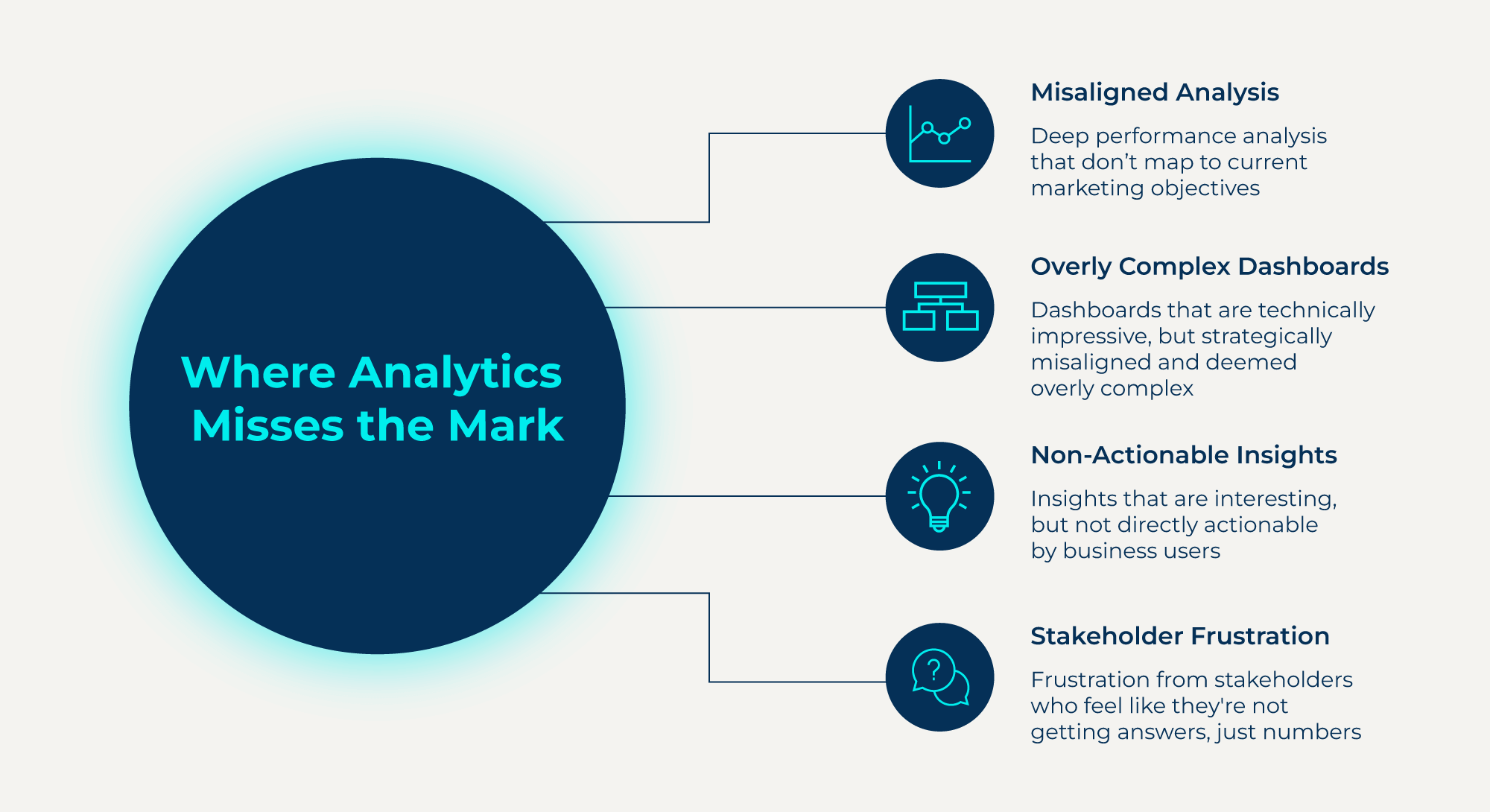
As an Analytics Leader, you’ve built a capable team, invested in the right tools, and established a robust reporting infrastructure and likely even started to apply AI and Machine Learning to drive innovation and scale. On paper, everything looks solid. But in the boardroom—or in cross-functional meetings—there’s still a disconnect.
Marketing is asking for actionable insights. Product wants to know what to build next. Leadership is pressing for answers that guide investment. Yet, too often, analytics is stuck answering the wrong questions—or delivering results that fail to drive decisions.
This isn’t a capability gap. It’s context and potentially a strategic alignment gap.
Most analytics teams are excellent at what they’re trained to do: surface patterns, analyze performance, build reports. But if they don’t fully understand the business context—the “why” behind the work—they risk producing outputs that check a box rather than influence action.

If this sounds familiar, you’re not alone. Many high-performing analytics orgs hit this wall. They have the right technical resources—but lack the connective tissue between analysis and business value. There are many reasons why companies get here, some due to size / scale and others due to trust and confidence eroding between the groups every company has a slightly different story, but the same current state.
That’s where bringing in an external partner with strategic measurement expertise can unlock transformation and Blend360 has the experience and track record to help organizations excel here:
As an Analytics Leader, your job isn’t just producing accurate insights—it’s ensuring those insights move the business forward. To do that, your team needs not only technical skills, but strategic fluency. This applies not just to Marketing, but Supply Chain, Sales, Product Development, Pricing, etc. If the analytics team is just “working to work” much of those insights are going to lack the appropriate application to drive impact.
Bringing in the right partner doesn’t replace your analytics team—it elevates it. It helps embed business-first thinking into your analytics practice and closes the gap between analysis and action.
In today’s data-rich, decision-poor environment, success isn’t about generating more insights—it’s about generating the right ones, at the right time, in the right language.
If your analytics function is producing more output than impact, now is the time to reassess—and bring in the strategic help that can turn measurement into momentum.
As an Analytics Leader, you’ve built a capable team, invested in the right tools, and established a robust reporting infrastructure and likely even started to apply AI and Machine Learning to drive innovation and scale. On paper, everything looks solid. But in the boardroom—or in cross-functional meetings—there’s still a disconnect.
Marketing is asking for actionable insights. Product wants to know what to build next. Leadership is pressing for answers that guide investment. Yet, too often, analytics is stuck answering the wrong questions—or delivering results that fail to drive decisions.
This isn’t a capability gap. It’s context and potentially a strategic alignment gap.
Most analytics teams are excellent at what they’re trained to do: surface patterns, analyze performance, build reports. But if they don’t fully understand the business context—the “why” behind the work—they risk producing outputs that check a box rather than influence action.

If this sounds familiar, you’re not alone. Many high-performing analytics orgs hit this wall. They have the right technical resources—but lack the connective tissue between analysis and business value. There are many reasons why companies get here, some due to size / scale and others due to trust and confidence eroding between the groups every company has a slightly different story, but the same current state.
That’s where bringing in an external partner with strategic measurement expertise can unlock transformation and Blend360 has the experience and track record to help organizations excel here:
As an Analytics Leader, your job isn’t just producing accurate insights—it’s ensuring those insights move the business forward. To do that, your team needs not only technical skills, but strategic fluency. This applies not just to Marketing, but Supply Chain, Sales, Product Development, Pricing, etc. If the analytics team is just “working to work” much of those insights are going to lack the appropriate application to drive impact.
Bringing in the right partner doesn’t replace your analytics team—it elevates it. It helps embed business-first thinking into your analytics practice and closes the gap between analysis and action.
In today’s data-rich, decision-poor environment, success isn’t about generating more insights—it’s about generating the right ones, at the right time, in the right language.
If your analytics function is producing more output than impact, now is the time to reassess—and bring in the strategic help that can turn measurement into momentum.